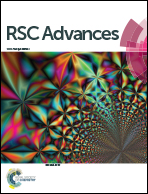Preparation and evaluation of hypocrellin A loaded poly(lactic-co-glycolic acid) nanoparticles for photodynamic therapy†
Abstract
Hypocrellin A (HA), a perylenequinoid pigment isolated from a traditional Chinese medicinal fungus, exhibits excellent antiviral and antitumor properties. However, its hydrophobicity, photodegeradation and dark cytotoxity hamper its clinical application. The aim of the present study is to prepare and evaluate HA loaded poly(lactic-co-glycolic acid) (PLGA) nanoparticles, which can be dispersed in water. In this present study, an oil-in-water (O/W) emulsion solvent evaporation technique was employed to fabricate hypocrellin A loaded poly(D,L-lactic-co-glycolic) nanoparticles. The physiochemical properties and morphological characteristics were examined. The photostability, uptake and in vitro phototoxicity and dark toxicity toward A549 cells were evaluated. Scanning electron microscopy (SEM) and confocal laser microscopy (CLSM) images combined with dynamic light scattering (DLS) measurements and surface charge (ζ-potential) results showed that the as-prepared HA-loaded nanoparticles had a narrow dispersity with a surface charge of −5.8 mV. The physicochemical properties of the as-prepared nanoparticles were characterized by differential scanning calorimetry (DSC), X-ray powder diffractometry (XRD) and Fourier transform infrared (FTIR) spectroscopy. The encapsulation efficiency and drug content were 55.1% and 5.0%, respectively. UV-vis spectra and the results from photobleaching experiments indicated that encapsulation could enhance the photostability of HA. In vitro experiments demonstrated that HA loaded PLGA nanoparticles were taken up by A549 cells and significantly exhibited reduced dark cytotoxicity, while maintaining excellent anti-tumor property and ROS production ability. These promising results suggested that nanotechnology provide an intriguing possibility for HA being a potent photosensitizer (PS) in clinical photodynamic therapy (PDT).


 Please wait while we load your content...
Please wait while we load your content...